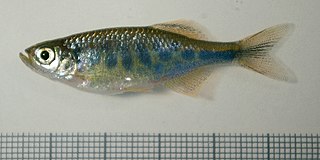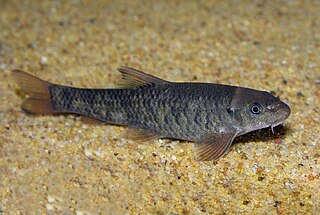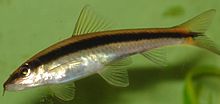
Devario is a genus of fish in the family Cyprinidae native to the rivers and streams of South and Southeast Asia. These fishes have short barbels and many species having vertical or horizontal stripes. These species consume various small, aquatic insects, crustaceans and worms, as well as, in the case of fry, plankton.

Rasbora is a genus of fish in the family Cyprinidae. They are native to freshwater habitats in South and Southeast Asia, as well as southeast China. A single species, R. gerlachi, is only known from an old specimen that reputedly originated from Africa (Cameroon), but this locality is considered doubtful. They are small, up to 17 cm (6.7 in) long, although most species do not surpass 10 cm (4 in) and many have a dark horizontal stripe.

Sundadanio is a genus of cyprinid fishes from freshwater habitats, typically peat swamps and blackwater streams, in Borneo and Sumatra in southeast Asia. At up to 2.3 cm (0.91 in) in standard length they are very small, but still larger than their close relatives Paedocypris. Species of the two genera are often found together.
Tariqilabeo is a genus of fish in the family Cyprinidae native to Asia.

Sundadanio axelrodi is a danionin in the family Cyprinidae, with origin from Borneo, Bangka, and Sumatra. Originally described as a rasbora, Rasbora axelrodi, this tiny species was later deemed to be more closely related to the danios but not enough to be moved into the genus Danio. Sundadanio axelrodi reaches a maximum size of 1.7 cm. Sundadanio was considered monotypic until the genus was reassessed by Conway, Kottelat and Tan in 2011.

Barbodes is a genus of small to medium-sized cyprinid fish native to tropical Asia. The majority of the species are from Southeast Asia. Many species are threatened and some from the Philippines are already extinct. A survey carried out in 1992 only found three of the endemic Barbodes species, and only two were found in 2008. Several members of this genus were formerly included in Puntius.

Hemibagrus is a genus of catfishes of the family Bagridae.

Garra is a genus of fish in the family Cyprinidae. These fish are one example of the "log suckers", sucker-mouthed barbs and other cyprinids commonly kept in aquaria to keep down algae. The doctor fish of Anatolia and the Middle East belongs in this genus. The majority of the more than 160 species of garras are native to Asia, but about one-fifth of the species are from Africa.

Nemacheilus is a genus of stone loaches native to Asia.
Tylognathus is an invalid genus of ray-finned fishes in the family Cyprinidae. It was established by Heckel in 1843 without a type species. Varicorhinus diplostomus, described by Heckel in 1838 and erroneously redescribed by the same author in 1844 as T. valenciennesii, was later designated the type species. Today this fish is placed in the genus Bangana.

Epalzeorhynchos is a small ray-finned fish genus of the family Cyprinidae. Its members are – like some other cyprinids – known as "freshwater sharks" or simply "sharks". They are, however, freshwater members of the Osteichthyes lineage which is distinct from the Chondrichthyes lineage of sharks. The description of these animals as "shark" is most likely a reference to the shark-like shape of these popular cyprinids.

Lobocheilos is a genus of fish in the family Cyprinidae native to Asia.

Mystacoleucus is a genus of freshwater ray-finned fish belonging to the family Cyprinidae, the family which includes the carps, barbs, minnows and related fishes. The fishes in this genus are found in Southeast Asia.

Osteochilus is a genus of cyprinid fishes mainly found in Southeast Asia with a few extending into adjacent parts of China. Additionally, two species are endemic to the Western Ghats in India.
Crossocheilus elegans is a fish species in the genus Crossocheilus from northern Borneo, Indonesia. Its distribution is the Segama and Kinabatangan River drainages in Sabah, Malaysia.
Tariqilabeo periyarensis is a species of fish in the family Cyprinidae. This species is only found in Periyar River in Kerala, India.

Laubuka is a genus of cyprinid fish found in South and Southeast Asia.

Crossocheilus langei, also known as the red algae eater, is a species of ray-finned fish in the genus Crossocheilus. It is native to Malaysia and Sumatra. This bottom-dwelling tropical fish is found in mainland Southeast Asia. Its natural habitats are streams and rivers as well as flooded forests during the rainy season. It is often confused with the Crossocheilus oblongus, however, both are algae eaters and will behave similarly.
Altigena is a genus of cyprinid freshwater fish found in the continental part of South East Asia. This genus was resurrected from Bangana by Maurice Kottelat in 2017.














